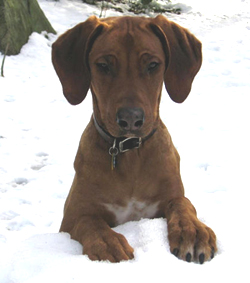Intervertibral Disk Disease is an abnormality of discs providing cushioning between vertebra. A disc is tough, fibrous connective tissue, cartilage. There are two types of Intervertibral Disc Disease (IVDD).
Hansen Type 1 occurs when the connective tissue ruptures and the gel-like center pushes out through the opening affecting the spinal cord. This type may be seen in breeds with inherited skeletal deformities such as the Dachshund, Basset Hound, Corgi, Beagle, Cocker Spaniel, Sussex Spaniel and others.
Hansen Type 2 is when the entire disc bulges outward which occurs gradually over a period of time. It is usually seen in older dogs, especially those who are overweight. Breeds prone to this form of IVDD are German Shepherds, Labrador Retrievers, Doberman Pinchers.
Cats can develop IVDD, usually between the ages of 8-10 years old.
Signs to look for are difficulty moving the neck or head, carrying the head low, back pain, hunched-up position, tight abdomen. The dog may cry out in pain when touched in the injured area. Dogs can have lameness, a wobbly gait, they may pant and tremble. Sometimes, when there is a sudden disc rupture, the hindquarters can become partially or wholly paralyzed.
According to the Southeast Veterinary Neurology Center, veterinarians use this scale to determine the severity of the condition:
• Level 1 – Pain only: These dogs are able to walk normally, but exhibit signs of pain including reluctance to jump or even move, crying, trembling, having muscle spasms and/or a tense abdomen.
• Level 2 – Ambulatory paraparesis (partial paralysis affecting the lower limbs): These dogs are able to walk, but when they do they’re weak and wobbly in the hind legs. Their back legs may even cross when they’re trying to walk. The back legs may also splay out, knuckle over or the dog may stumble or seem unsteady in his hind quarters.
• Level 3 – Non-ambulatory paraparesis: These dogs are still able to move their legs and wag their tails, but they’re not strong enough to stand up or support their own weight with their back legs.
• Level 4 – Paraplegia: These dogs have no voluntary movement in their back legs.
• Level 5 – Paraplegia with no deep pain perception: In addition to being unable to move their hind legs, they are unable to even feel their hind legs.
A complete neurological examination is necessary for diagnosis. X-rays can rule out other causes of spinal problems and point to the location of the injury. But an MRI is necessary to view the spinal cord, nerve roots and intervertibral disc. Your veterinarian may suggest a mylegram (dye injected into the spine under anesthesia) to be able to see the spinal cord with x-ray. A spinal tap is sometimes used to check cerebral spinal fluid and rule out other causes.
The aim of treatment of IVDD is to remove spinal cord pressure and inflammation to relieve pain. Depending on the severity of the disease, surgery may be recommended to offer the dog a good quality of life.
With early diagnosis and treatment or surgery, the disease can usually be managed and heal more quickly. There are a number of therapies which your vet can recommend – corticosteriods, massage, accupuncture, laser therapy, water therapy, walking a treadmill – when your dog is ready.
Following surgery it’s important for the dog to have complete rest for the amount of time advised by the veterinarian. A comfortable bed, assistance with potty needs, eating and drinking are necessary. If the dog can’t move on its own, turning every few hours can avoid bedsores.
Keeping your dog at the proper weight and physical therapy can help avoid recurrence of IVDD.



